The NVIDIA GeForce GTX 970 Review: Featuring EVGA
by Ryan Smith on September 26, 2014 10:00 AM ESTOverclocking
With GTX 980 we saw first-hand how GM204 had very significant overclocking headroom. Even without the ability to meaningful overvolt on NVIDIA cards, we were able to push our base GPU clock speed up from 1126MHz to 1377MHz, or in terms of the maximum boost bin, from 1265MHz to 1515MHz. Consequently with GTX 970 shipping at lower clock speeds, we have very lofty expectations here.
But running counter to that will be TDP. As we have already seen, GTX 970 is TDP limited right out of the gate, so even if our card has more clock speed headroom, its 110% TDP limit doesn’t leave much more in the way of power headroom. Furthermore as this is already a factory overclocked card, there’s no guarantee that EVGA has left us much overclocking headroom to play with in the first place.
| EVGA GeForce GTX 970 FTW Overclocking | ||||
| FTW | Overclocked | |||
| Core Clock | 1216MHz | 1241MHz | ||
| Boost Clock | 1367MHz | 1392MHz | ||
| Max Boost Clock | 1418MHz | 1455MHz | ||
| Memory Clock | 7GHz | 7.8GHz | ||
| Max Voltage | 1.218v | 1.243v | ||
And in fact our results show they haven’t. We aren’t able to get even another 50MHz out of our GPU before errors start setting in; 25MHz is all we will get, which pushes our base GPU clock speed from 1216MHz to 1241MHz, and our maximum boost clock from 1418MHz to 1455MHz. Overall this is a weaker overclock than GTX 980, though not immensely so.
Meanwhile memory overclocking was just as fruitful as it was on GTX 980, with our card being able to handle up to 7.8GHz on its GDDR5 memory. As we saw with GTX 980 we’re nearly as memory bandwidth bottlenecked as we are GPU bottlenecked, but we will take what performance we can get.
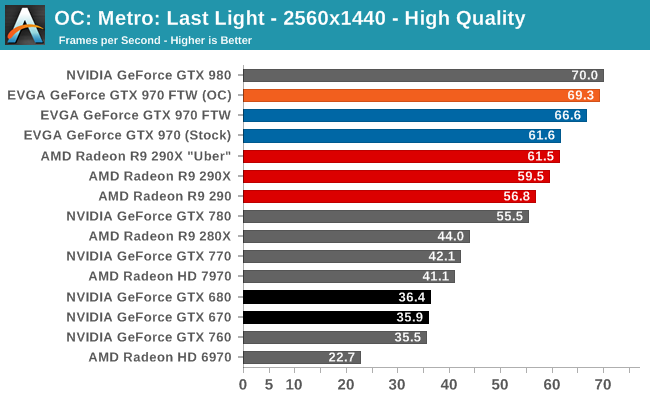
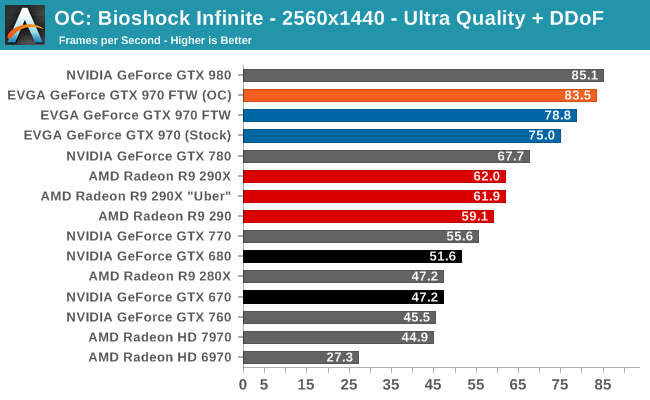
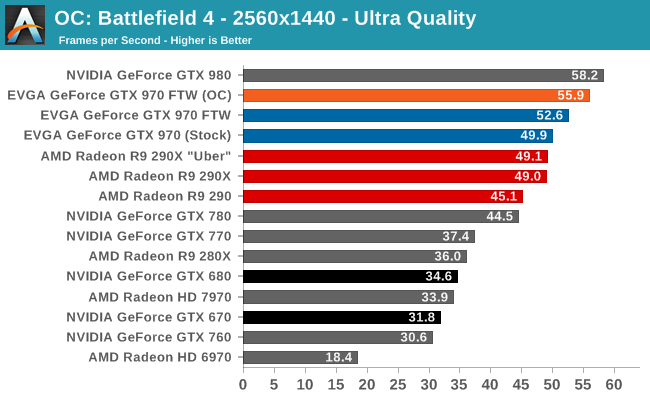

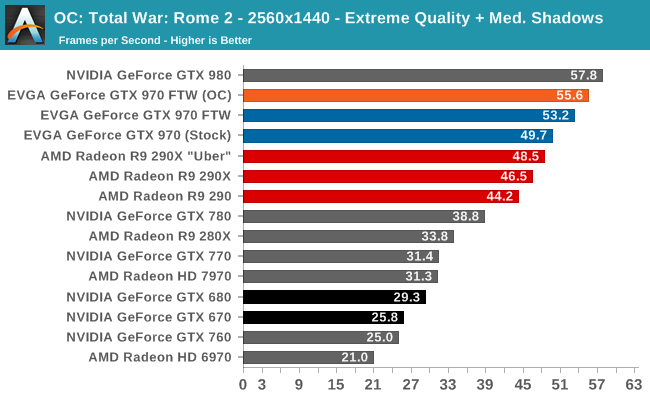
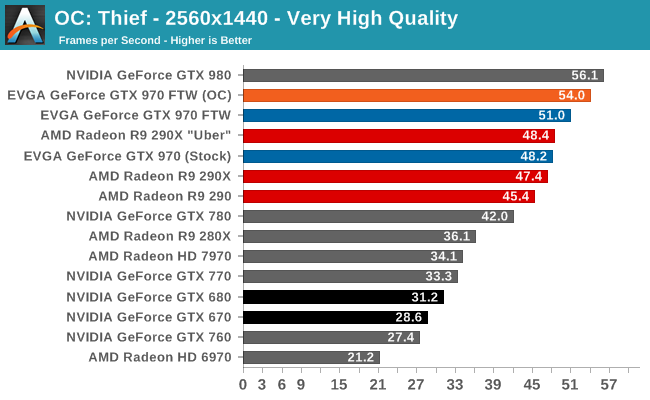
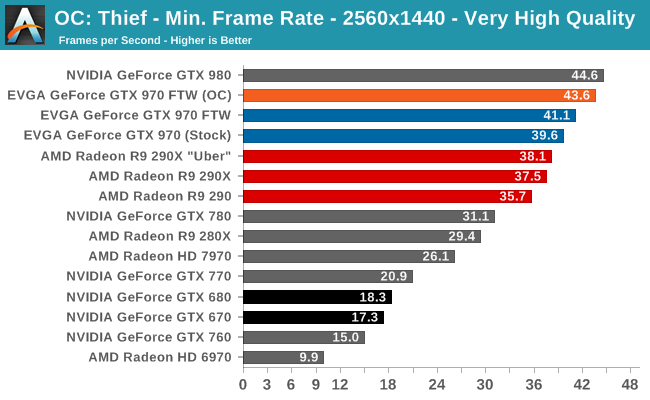
As you’d expect from such a mild overclock, the performance increase is very limited. Our overclocked GTX 970 FTW does close on GTX 980 even more, but even with this full overclock it won’t overcome the 3 SMM deficit.
Overall in all likelihood the GTX 970 FTW benefits more from the 10% increase in TDP than it does the clock speed increase. GTX 970 – and GM204 in general – clearly desires to be fed with more voltage and more power overall than what any NVIDIA approved card is going to see.
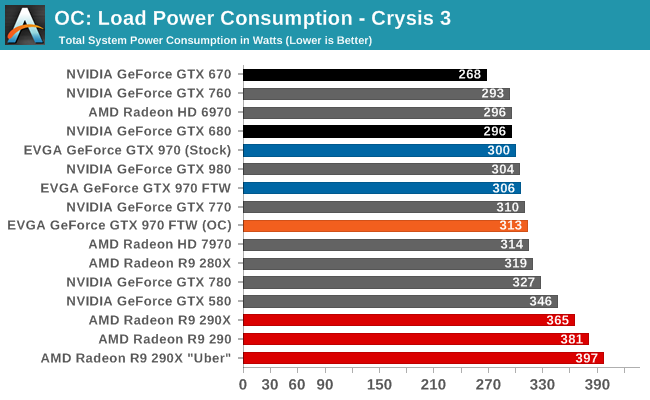
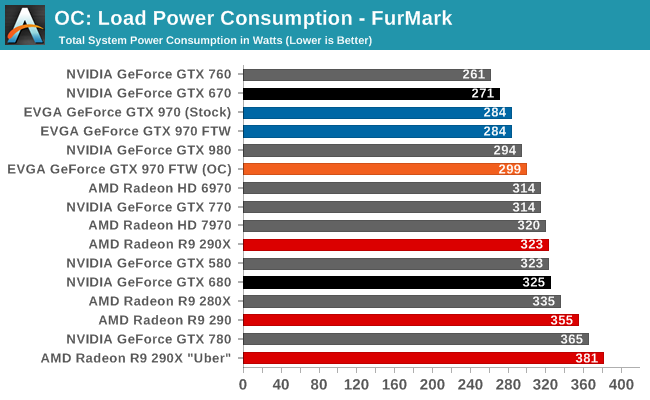
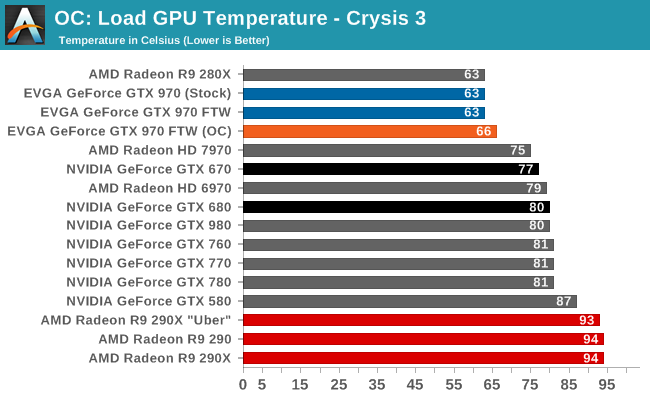
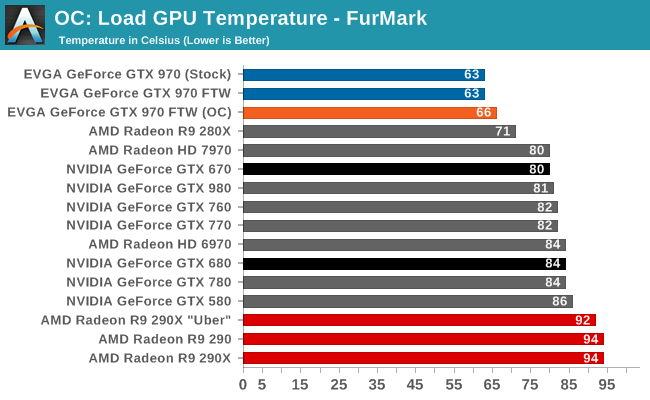
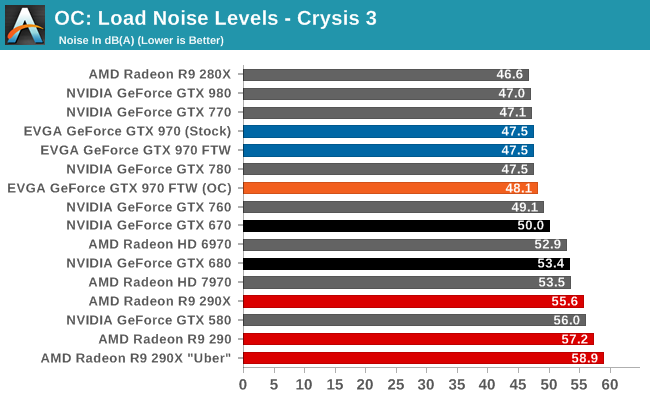
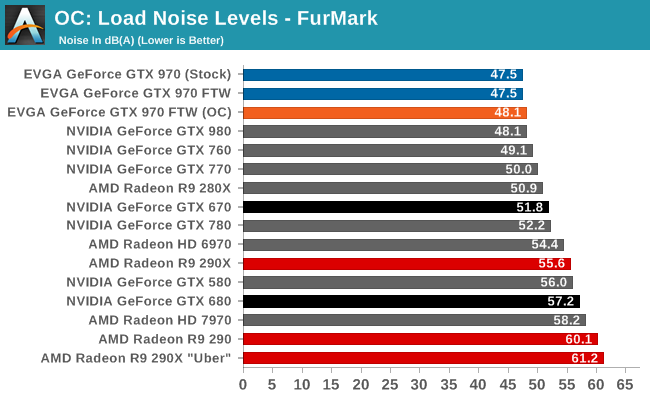
Power consumption and noise tick up, but only slightly. The limited 10% TDP increase means that the amount of power the card can draw and dissipate as heat only increases slightly. You aren’t getting much more performance, but you also aren’t getting much more noise.










155 Comments
View All Comments
vred - Friday, September 26, 2014 - link
Memory chips don't really need heatsinks, but memory VRMs do - so if overclocking memory, you have to watch their temperature and take care of their proper cooling.eanazag - Friday, September 26, 2014 - link
I am happy to see both Nvidia cards come out packing heat. for once Nvidia isn't totally price gouging at launch. In fact, we should see AMD prices come down soon as AMD reviews Nvidia's sales numbers. The 290 and 290X are pushing like 10 months on the clock at pretty much launch prices. it is about time we the price have a reason to come down. The 970 is the card to do so.Assumedly, Nvidia already has the 980 TI taped out for AMDs next response card. I am disappointed to see that there is no builtin audio decoder like in AMD. It means little hope to see many developers leveraging audio hardware to reduce CPU load in games with 5.1+ situations.
JlHADJOE - Saturday, September 27, 2014 - link
I doubt we'll see a 980Ti. Like the 680 before it, the 980 is already a fully enabled chip.Kraelic - Saturday, September 27, 2014 - link
It is a GM204 upper-midrange chip as were any Gxx04 chips before... this is like the launch of the 680 and 670 GK104 cards, then in the refresh 770 and 760 used those same chips when the 780 GK110 high end came out with the true flagship core.There will be a GM210 flagship taking the titan and x80 name, and the GM204 will go into the x70 and x60 cards at a lower price and this refresh is what I am interested in.
randomhkkid - Saturday, September 27, 2014 - link
However like the 780 before it is is also a Gxx04 chip so therefore there will be a Gxx10 chip above it suited to cards like the 980ti as was the case with the 780ti.randomhkkid - Saturday, September 27, 2014 - link
beaten to it ;)Samus - Sunday, September 28, 2014 - link
we'll probably see a 980Ti in the form of a 20nm part. even if there is no architectural difference they could tweak it for a smaller process while possibly boosting the clock. who knows...1500MHz GPU & 8GHz GDDR5?squngy - Thursday, November 20, 2014 - link
I'm not up to date, but if crypto-currency miners are still interested in radeon cards AMD might not rush to lower the price, or if they do the retailers will just pocket the difference and sell at the same price.AnnonymousCoward - Saturday, September 27, 2014 - link
A 10% OC won't heat a chip to the point of damage. You will most likely first reach the point when the memory fails to function.Btw Ryan, you keep saying it's "clocked at 7GHz" but I don't think that's true. Probably need to add the word "effective". Is the real clock 1/2 or 1/4 that?
MrSpadge - Saturday, September 27, 2014 - link
You'll frequently see 1/4 in OC tools. In the end it doesn't matter, both numbers are valid: one is the frequency of the data on the bus (the high marketing number) and the other one is the frequency of the memory chips.